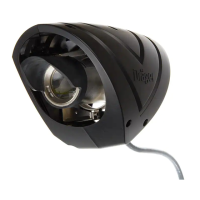Understanding The System
8
Gas calibration and zeroing
Dräger Polytron Pulsar 2 is sensitive to a wide range of gaseous hydrocarbons, including the alkane series from methane to hexane. In
contrast to instruments working at 3.4 μm, the difference in response to different alkanes is relatively small, of the order of ±30%. The
Receiver has provision for up to four factory-installed tables providing the calibration and linearisation for specified gases or gas mixtures.
The choice of which table is used is configurable by the user. For most applications a Methane table should be selected for mixtures that
are predominantly methane, a Propane table otherwise. There is also a factory-installed option for the Receiver to be optimised for the
detection of Ethylene (ethene).
Unlike conventional detectors Dräger Polytron Pulsar 2s built-in calibrations need no manual adjustment, but a self-zeroing sequence is
initiated by the Handheld Terminal to complete the commissioning of the detector. The Receiver checks its own and the Transmitter's
alignment, and checks and records the signal strength. The zeroing can only be completed if all the checks are passed, and until then a
new detector reads full scale and is not useable. The recorded signal strength is used as a reference to detect a loss of signal as the
lenses become dirty. For this reason the zeroing should be carried out in clear conditions, at moderate temperature, and without the
beam being interrupted. A Polytron Pulsar 2 should always be re-zeroed whenever it is re-sited, cleaned or re-aligned.
The Calibration Certificate supplied with each Dräger Polytron Pulsar 2 states the lower explosive limit (LEL)
*)
or lower flammable limit
(LFL) value that was used for each gas. Normally this is to IEC 61779-1 for Dräger Polytron Pulsar 2s supplied with an ATEX certification,
or values published by the American National Institute for Occupational Safety and Health (NIOSH) for those with North American and
Canadian certifications. The choice of standard used for the factory calibration can be varied to special order.
Generally, the relatively small differences in the values between the calibration standards is of less consequence for open path instru-
ments than for point detectors, since they do not normally measure gas concentration directly but with a weighting according to the size
of a spreading gas cloud. Arising naturally from the way they work, all 'line of sight' detectors measure the total quantity of gas that the
beam intercepts. A flammable gas detector reads the concentration in LEL times the length of path that the gas occupies (usually less
than the whole Transmitter-Receiver path), making the appropriate units for the measurement LEL metres (LELm). The only exception is
when a uniform concentration completely fills a path of defined length, allowing a true measurement of concentration and the appropriate
units to be %LEL as for the Duct-Mounted Dräger Polytron Pulsar 2 (see separate manual).
Each of Dräger Polytron Pulsar 2s linearisation tables covers the range 0 to 8 LELm and this full range of measurement is always availa-
ble in the digital data stream. The user can configure the span of the 4-20 mA output to any value between 0 4 LELm and 0 8 LELm. Note
that a choice other than 0 8LELm does not alter the underlying measurement, but causes readings between the chosen full scale and 8
LELm to be clamped at 20mA.
The installation kit includes plastic test sheets which mimic the infrared absorption of the gases to be detected. They are not used for cal-
ibration but provide a convenient check that the detector retains its factory-set calibration and is working correctly. The sheets are marked
with their thickness in micrometres (eg 070 = 0.070 mm). The Dräger Polytron Pulsar 2s Calibration Certificate includes its response to
similar sheets at the factory. Note that different sheets, each of an appropriate plastic film, are used for the standard
Dräger Polytron Pulsar 2 and for the Ethylene (ethene ) optimised version.
*) Within this Installation Manual the terms LEL and LFL are interchangeable and refer to the volume ratio of flammable gas in air below which an
explosive atmosphere will not form.

